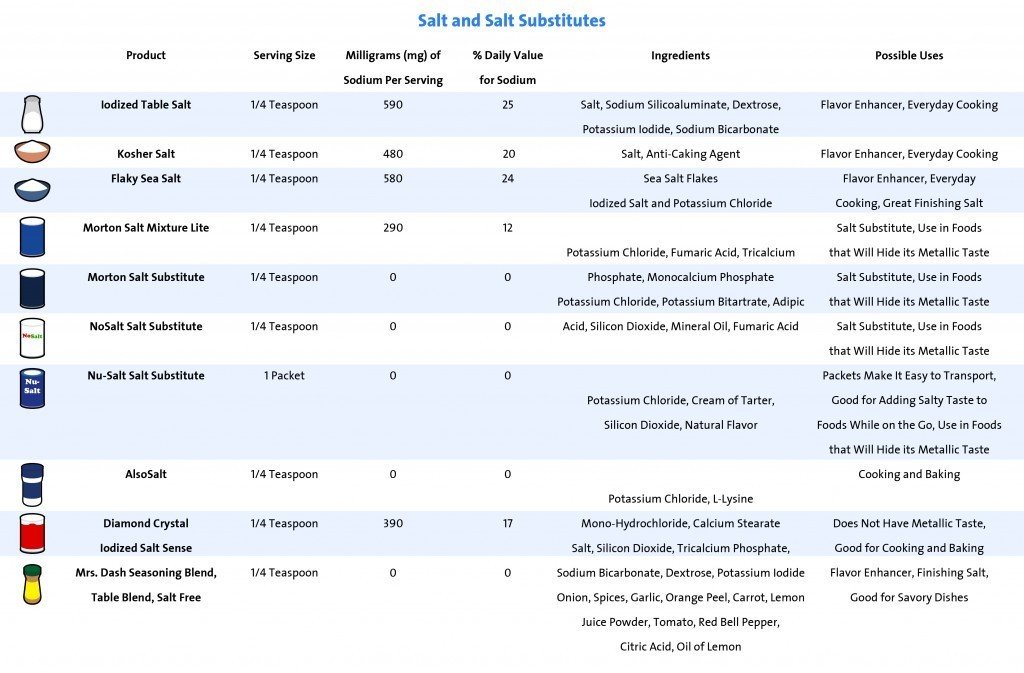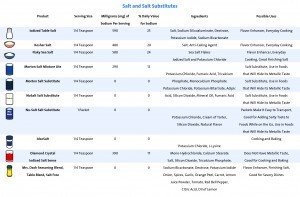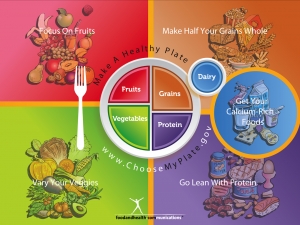Salt Substitutes Chart
It's time to talk about salt again! Remember how many health organizations have advised people to reduce their sodium intake? Apparently almost all Americans consume way too much salt, every day. One way that people can reduce their salt intake is by using salt substitutes.What do you know about salt substitutes?I want to shed some light on this topic today. My team and I have exhaustively researched 10 different varieties of salt and salt substitutes, and we've compiled the highlights of what we found into a handy-dandy chart. Would you like to see it? Dealing with salt substitutes can be tricky. Even regular old table salt had layers of complexity we hadn't anticipated. Who knew that there was such a long ingredient list for everyday salt? For cleanest flavor, a flaky sea salt may be best, while people who are at risk of goiter and other iodine-deficiency-related conditions should be sure to get iodized salt. Flaky sea salt tastes less salty than regular table salt, with kosher salt falling somewhere in between.But now let's talk salt substitutes. Most salt-free options and salt blends use potassium chloride, a salty-tasting compound that has an unmistakably bitter taste. It can be hard to mask this metallic flavor, so if you're using a salt substitute, be sure to use it in foods that could outshine that taste. It's also worth noting that potassium chloride can interact with some medications and cause seriously dangerous side effects. For example, according to the study Danger of salt substitutes that contain potassium in patients with renal failure,"Salt substitutes that contain potassium may cause hyperkalaemia with life threatening consequences in susceptible patients." Susceptible patients include people with diabetes, heart failure, and kidney failure. You see, some medications make it harder for the body to get rid of excess potassium, and may lead to fatal medical complications when combined with certain salt substitutes. If you are taking any medications, talk with your doctor before using a salt substitute.Of course, there are salt-free flavoring alternatives as well. Consider trying a sodium-free seasoning blend like the product from Mrs. Dash that's featured in the chart above. You can also make your own herb and spice blend!What do you think? Now that you have access to all the information in the chart, will you stick to table salt?Oh, and would you like to save and print this chart? It's a great resource to help clients compare sodium content, ingredient lists, culinary uses, and more! Here's a handy PDF version...
Dealing with salt substitutes can be tricky. Even regular old table salt had layers of complexity we hadn't anticipated. Who knew that there was such a long ingredient list for everyday salt? For cleanest flavor, a flaky sea salt may be best, while people who are at risk of goiter and other iodine-deficiency-related conditions should be sure to get iodized salt. Flaky sea salt tastes less salty than regular table salt, with kosher salt falling somewhere in between.But now let's talk salt substitutes. Most salt-free options and salt blends use potassium chloride, a salty-tasting compound that has an unmistakably bitter taste. It can be hard to mask this metallic flavor, so if you're using a salt substitute, be sure to use it in foods that could outshine that taste. It's also worth noting that potassium chloride can interact with some medications and cause seriously dangerous side effects. For example, according to the study Danger of salt substitutes that contain potassium in patients with renal failure,"Salt substitutes that contain potassium may cause hyperkalaemia with life threatening consequences in susceptible patients." Susceptible patients include people with diabetes, heart failure, and kidney failure. You see, some medications make it harder for the body to get rid of excess potassium, and may lead to fatal medical complications when combined with certain salt substitutes. If you are taking any medications, talk with your doctor before using a salt substitute.Of course, there are salt-free flavoring alternatives as well. Consider trying a sodium-free seasoning blend like the product from Mrs. Dash that's featured in the chart above. You can also make your own herb and spice blend!What do you think? Now that you have access to all the information in the chart, will you stick to table salt?Oh, and would you like to save and print this chart? It's a great resource to help clients compare sodium content, ingredient lists, culinary uses, and more! Here's a handy PDF version... For even more information, check out the expanded (and member-exclusive) sodium chart featured in the post Expanded Salt Substitute Chart! It has a comprehensive guide to 5 more salts and salt substitutes, including Himalayan pink salt, seaweed granules, Bragg nutritional yeast seasoning, and more!
For even more information, check out the expanded (and member-exclusive) sodium chart featured in the post Expanded Salt Substitute Chart! It has a comprehensive guide to 5 more salts and salt substitutes, including Himalayan pink salt, seaweed granules, Bragg nutritional yeast seasoning, and more! And remember, we're here to help you look your very best, right now! Don't miss these top-selling materials from the Nutrition Education Store...
And remember, we're here to help you look your very best, right now! Don't miss these top-selling materials from the Nutrition Education Store...




